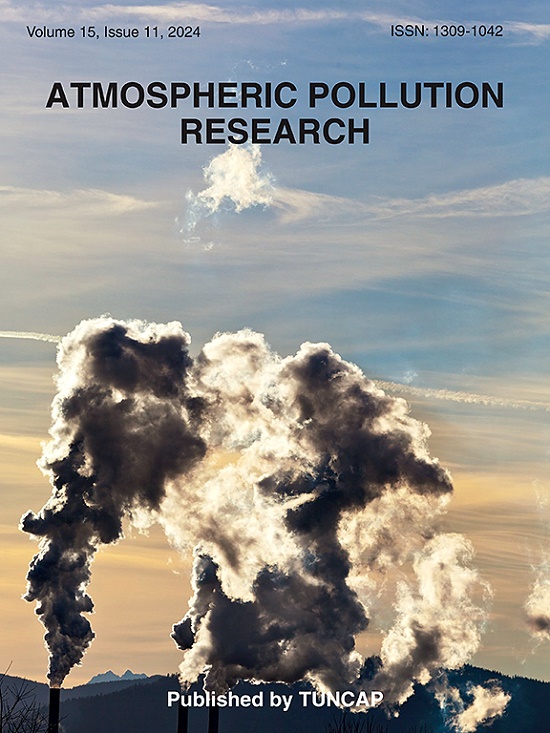High resolution variability in wet deposition in the southeastern United States
IF 3.5
3区 环境科学与生态学
Q2 ENVIRONMENTAL SCIENCES
引用次数: 0
Abstract
Rainwater chemistry is determined by atmospheric pollutants and particles which vary spatially and temporally. Industrial and agricultural activities and meteorological events (e.g. sea breezes, severe weather, blowing dust) alter atmospheric particle and trace gas compositions. These gases and particles are scavenged by cloud and rain droplets that drive wet deposition. During an Intensive Operation Period (IOP) from April to October 2021, rainwater was collected at higher frequency intervals, usually daily, after precipitation events at three locations on the Savannah River Site (SRS). The farthest locations were separated by approximately 20 km. The mean concentration (μeq/L) of seven ions followed the Cl− > SO42− > Na+ > NO3− > K+ > Mg2+ > Ca2+ downward trend. Ion concentrations were compared to background ion concentrations from the National Atmospheric Deposition Program (NADP). The high frequency monthly averaged SRS data compared well with the monthly averaged NADP background but demonstrated extensive variability. In some months in 2021, the high frequency data compared better to the NADP site near the coast while in other months inland sites compared better. Strong spatial variability for ion concentrations was observed across SRS which was attributed to localized impacts in rainfall spatial variability. High frequency measurements allowed for comparison to regional weather patterns indicating influences from the Atlantic Ocean, Gulf of Mexico, and cities. This can account for spatial variability in the wet deposition flux. Sea breezes, Saharan dust, and anthropogenic sources were shown to impact wet deposition flux variability. Higher frequency precipitation chemistry sampling at numerous locations better captures ion concentration variability and improves measurement representativeness.
美国东南部湿沉积的高分辨率变异性
雨水化学是由大气污染物和颗粒物在时空上的变化所决定的。工业和农业活动以及气象事件(如海风、恶劣天气、飞扬的灰尘)改变了大气颗粒和微量气体的组成。这些气体和颗粒被云和雨滴清除,导致湿沉积。在2021年4月至10月的密集运行期(IOP),在萨凡纳河站点(SRS)的三个地点的降水事件后,以更高的频率间隔(通常为每日)收集雨水。最远的地点相距约20公里。7个离子的平均浓度(μeq/L)依次为Cl−>;SO42−祝辞Na +比;3号−祝辞K +比;Mg2 +比;Ca2+呈下降趋势。离子浓度与国家大气沉积计划(NADP)的背景离子浓度进行了比较。高频月平均SRS数据与月平均NADP背景数据比较良好,但表现出广泛的变异性。在2021年的某些月份,高频数据与海岸附近的NADP站点相比更好,而在其他月份,内陆站点的数据更好。在SRS区域,离子浓度具有较强的空间变异性,这归因于降雨空间变异性的局域影响。高频率的测量可以与表明大西洋、墨西哥湾和城市影响的区域天气模式进行比较。这可以解释湿沉积通量的空间变异性。海风、撒哈拉沙尘和人为来源已被证明会影响湿沉积通量变率。在许多地点进行高频降水化学取样,可以更好地捕捉离子浓度的变化,提高测量的代表性。
本文章由计算机程序翻译,如有差异,请以英文原文为准。
求助全文
约1分钟内获得全文
求助全文
来源期刊

Atmospheric Pollution Research
ENVIRONMENTAL SCIENCES-
CiteScore
8.30
自引率
6.70%
发文量
256
审稿时长
36 days
期刊介绍:
Atmospheric Pollution Research (APR) is an international journal designed for the publication of articles on air pollution. Papers should present novel experimental results, theory and modeling of air pollution on local, regional, or global scales. Areas covered are research on inorganic, organic, and persistent organic air pollutants, air quality monitoring, air quality management, atmospheric dispersion and transport, air-surface (soil, water, and vegetation) exchange of pollutants, dry and wet deposition, indoor air quality, exposure assessment, health effects, satellite measurements, natural emissions, atmospheric chemistry, greenhouse gases, and effects on climate change.
 求助内容:
求助内容: 应助结果提醒方式:
应助结果提醒方式:


